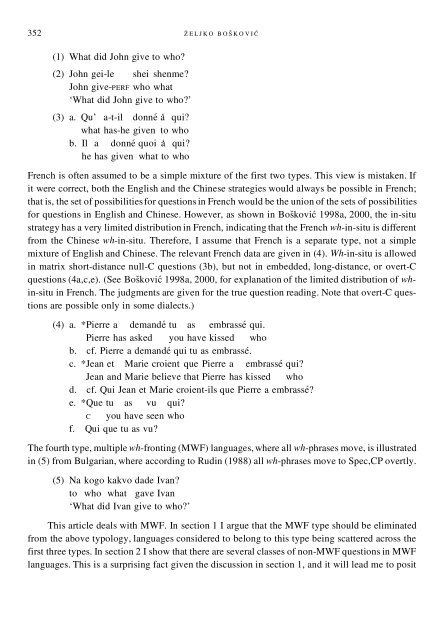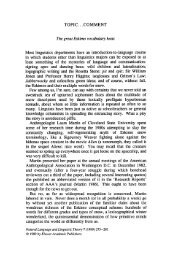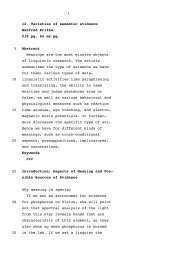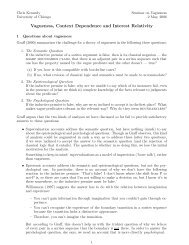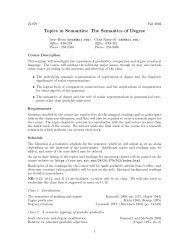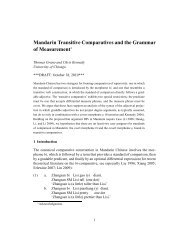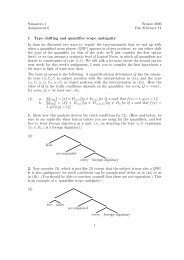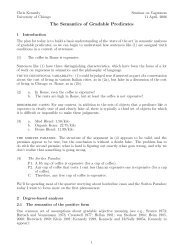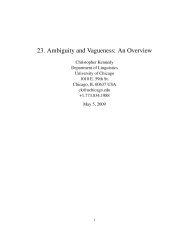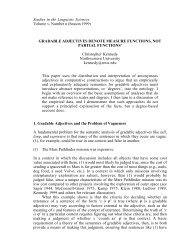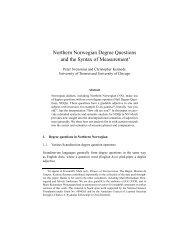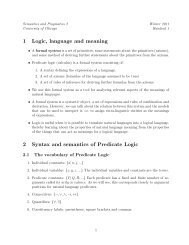On Multiple Wh-Fronting - University of Chicago
On Multiple Wh-Fronting - University of Chicago
On Multiple Wh-Fronting - University of Chicago
You also want an ePaper? Increase the reach of your titles
YUMPU automatically turns print PDFs into web optimized ePapers that Google loves.
352 ZÏ E L J K O B O SÏ K O V I Ć(1) <strong>Wh</strong>at did John give to who?(2) John gei-le shei shenme?John give-PERF who what‘<strong>Wh</strong>at did John give to who?’(3) a. Qu’ a-t-il donné a‘ qui?what has-he given to whob. Il a donné quoi a‘ qui?he has given what to whoFrench is <strong>of</strong>ten assumed to be a simple mixture <strong>of</strong> the first two types. This view is mistaken. Ifit were correct, both the English and the Chinese strategies would always be possible in French;that is, the set <strong>of</strong> possibilities for questions in French would be the union <strong>of</strong> the sets <strong>of</strong> possibilitiesfor questions in English and Chinese. However, as shown in BosÏ ković 1998a, 2000, the in-situstrategy has a very limited distribution in French, indicating that the French wh-in-situ is differentfrom the Chinese wh-in-situ. Therefore, I assume that French is a separate type, not a simplemixture <strong>of</strong> English and Chinese. The relevant French data are given in (4). <strong>Wh</strong>-in-situ is allowedin matrix short-distance null-C questions (3b), but not in embedded, long-distance, or overt-Cquestions (4a,c,e). (See BosÏ ković 1998a, 2000, for explanation <strong>of</strong> the limited distribution <strong>of</strong> whin-situin French. The judgments are given for the true question reading. Note that overt-C questionsare possible only in some dialects.)(4) a. *Pierre a demandé tu as embrassé qui.Pierre has asked you have kissed whob. cf. Pierre a demandé qui tu as embrassé.c. *Jean et Marie croient que Pierre a embrassé qui?Jean and Marie believe that Pierre has kissed whod. cf. Qui Jean et Marie croient-ils que Pierre a embrassé?e. *Que tu as vu qui?C you have seen wh<strong>of</strong>. Qui que tu as vu?The fourth type, multiple wh-fronting (MWF) languages, where all wh-phrases move, is illustratedin (5) from Bulgarian, where according to Rudin (1988) all wh-phrases move to Spec,CP overtly.(5) Na kogo kakvo dade Ivan?to who what gave Ivan‘<strong>Wh</strong>at did Ivan give to who?’This article deals with MWF. In section 1 I argue that the MWF type should be eliminatedfrom the above typology, languages considered to belong to this type being scattered across thefirst three types. In section 2 I show that there are several classes <strong>of</strong> non-MWF questions in MWFlanguages. This is a surprising fact given the discussion in section 1, and it will lead me to posit


